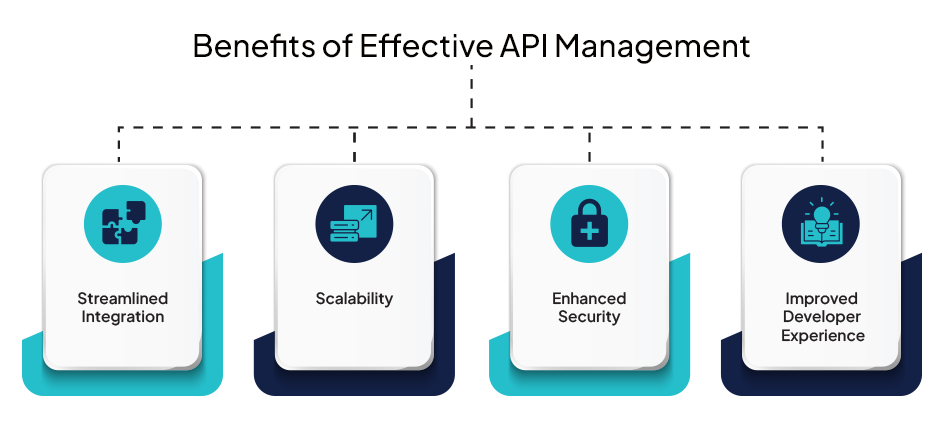
A Guide to Effective API Management in Financial Services
The financial services industry is undergoing a significant transformation due to the rise of Application Programming Interfaces (APIs). These digital tools facilitate seamless connectivity among banks, fintech firms, and other stakeholders, fostering innovative solutions and exceptional customer experiences.
Effective API management is a strategic necessity in the financial services industry, ensuring security, scalability, and performance to help institutions stay competitive in a digital landscape. Let’s delve into API management and how it can be harnessed in financial services to achieve operational excellence and customer satisfaction.
What is API Management?
 Let’s embark on a journey to understand this crucial aspect of the digital revolution in the financial services industry. API management oversees the entire lifecycle of APIs, from their creation and deployment to monitoring and retirement. It includes processes, tools, and policies designed to make APIs accessible, secure, and efficient for internal and external users. The primary aim of API management is to ensure seamless integration between various systems while providing a robust and user-friendly experience.
Let’s embark on a journey to understand this crucial aspect of the digital revolution in the financial services industry. API management oversees the entire lifecycle of APIs, from their creation and deployment to monitoring and retirement. It includes processes, tools, and policies designed to make APIs accessible, secure, and efficient for internal and external users. The primary aim of API management is to ensure seamless integration between various systems while providing a robust and user-friendly experience.
Key functions of API management include:
The Growing Need for APIs in Financial Services
 APIs are no longer just a convenience; they are the driving force behind innovation in financial services. They play a pivotal role in enabling digital transformation, enhancing customer experiences, and promoting open banking initiatives, painting a picture of a future filled with possibilities and forward-thinking solutions.
APIs are no longer just a convenience; they are the driving force behind innovation in financial services. They play a pivotal role in enabling digital transformation, enhancing customer experiences, and promoting open banking initiatives, painting a picture of a future filled with possibilities and forward-thinking solutions.
Digital transformation in financial services requires the seamless integration of new technologies with legacy systems. APIs make this possible by acting as a bridge, allowing institutions to modernize without overhauling their entire infrastructure.
For customers, APIs deliver convenience and personalization. They enable features like real-time payment updates, instant credit approvals, and customized investment recommendations. Open banking is a significant trend enabled by APIs that let customers securely share their financial data with third-party providers, fostering new and innovative services.
Core Components of API Management
API management is built on several foundational components, each critical to ensuring APIs’ effectiveness, security, and usability.
 API Gateway:
API Gateway:
The API gateway is the central hub for managing API traffic. It handles authentication, authorization, and request routing, ensuring smooth operations while balancing loads and mitigating potential disruptions. A well-functioning gateway is essential for maintaining performance, particularly in high-demand scenarios.
 Developer Portal:
Developer Portal:
Another vital component is the developer portal, which serves as a resource centre for developers. It provides access to API documentation, software development kits (SDKs), and testing environments, simplifying the integration process. A user-friendly portal enhances developer productivity and encourages innovation.
 API Analytics:
API Analytics:
API analytics is equally important, offering insights into usage patterns, performance metrics, and error rates. Analytics tools help organizations identify bottlenecks and optimize their APIs for better functionality and reliability.
 Security Features:
Security Features:
Robust security features are indispensable in API management, especially in financial services. SSL encryption, OAuth protocols, and firewalls safeguard data privacy and prevent unauthorized access. Regular audits and compliance checks enhance security, making APIs resilient against cyber threats.

Benefits of Effective API Management
The advantages of managing APIs effectively extend far beyond technical efficiency. For financial services, these benefits include:
Challenges in API Management for Financial Services
While API management offers immense potential, it comes with challenges, particularly in the highly regulated financial services sector.
 Security Risks:
Security Risks:
Security concerns are at the forefront. If not properly secured, APIs can become a gateway for cyberattacks, exposing sensitive financial data to hackers. Maintaining robust security while ensuring seamless functionality is a constant balancing act.
 Regulatory Compliance:
Regulatory Compliance:
Regulatory compliance poses another significant challenge. Financial institutions must comply with strict regulations, including GDPR, PSD2, and PCI DSS. Compliance for APIs requires careful planning, regular audits, and continuous monitoring.
 Legacy Systems:
Legacy Systems:
The integration of legacy systems further complicates API management. Many financial institutions still rely on outdated infrastructure, making it difficult to implement modern APIs without significant adjustments or overhauls. Bridging this gap requires specialized expertise and resources.
API Management Best Practices
Financial institutions should adopt these best practices to tackle challenges and maximize API potential:
 Implement API Versioning:
Implement API Versioning:
It is a critical step. By maintaining multiple versions of an API, organizations can ensure backward compatibility, allowing older systems to function seamlessly while rolling out updates.
 Prioritize Security:
Prioritize Security:
Security must be a top priority. Regular audits, token-based authentication, and encryption protocols like SSL are non-negotiable safeguards for APIs. Compliance with regulatory standards is equally important to avoid penalties and maintain trust.
 Invest in Monitoring:
Invest in Monitoring:
Monitoring and analytics play a key role in optimizing API performance. Organizations can identify inefficiencies by tracking usage metrics, latency, and error rates and make data-driven improvements. This ensures that APIs remain reliable and efficient, even as demands evolve.
Fostering a developer-friendly environment through comprehensive documentation, accessible tools, and responsive support is essential. A positive developer experience speeds up API adoption and encourages innovation and collaboration.
DataVision has been crafting software solutions for the Banking and Financial services industry for over 25 years.
Role of API Management in Open Banking
 Open banking is transforming financial services, with APIs at its centre. They enhance transparency, competition, and innovation by enabling secure data sharing between banks and third-party providers.
Open banking is transforming financial services, with APIs at its centre. They enhance transparency, competition, and innovation by enabling secure data sharing between banks and third-party providers.
Regulations such as the EU’s PSD2 mandate open banking initiatives are making API compliance an advantage and a necessity. Through effective API management, financial institutions can meet these regulatory requirements while creating opportunities for collaborative growth and customer-centric innovation.
Future Trends in API Management
The future of API management in financial services is bright, with emerging technologies poised to enhance capabilities further:
 AI Integration:
AI Integration:
Artificial Intelligence (AI) is set to revolutionize API management by automating processes, predicting user needs, and optimizing performance. AI-driven analytics can provide deeper insights into usage patterns, enabling organizations to improve proactively.
 Blockchain Applications:
Blockchain Applications:
Blockchain technology is another game-changer. Financial institutions can enhance security, transparency, and trust by integrating blockchain with APIs. This mainly benefits transactions and data sharing, where immutability and accountability are critical.
 Real-Time Data Processing:
Real-Time Data Processing:
Real-time data processing is becoming increasingly important as customers demand instant services. APIs are evolving to handle real-time data delivery, reducing latency and enabling faster decision-making. This trend is particularly relevant in areas like payments, fraud detection, and customer interactions.
Organizations that embrace innovation and adapt their API management strategies to these trends will thrive in the competitive financial services landscape.
Conclusion
API management is more than a technical framework; it is a strategic enabler of innovation in financial services. By adopting best practices, leveraging advanced tools, and staying ahead of trends, financial institutions can harness APIs’ full potential to deliver exceptional services and achieve sustainable growth.
FAQs
How Can Datavision help?
We assist various financial institutions and global banks on their digital transformation journey. Our one-of-a-kind approach, which combines people, process, and technology, expedites the delivery of superior results to our clients and drives excellence. Several reputed companies leverage our proprietary suite of business excellence tools and services to unlock new growth levers and unparalleled ROI.
Datavision stands proudly as a prominent banking software solutions provider, recognized for our unwavering commitment to excellence in the industry. We have earned our esteemed reputation by consistently delivering cutting-edge core banking software, catering to the needs of both retail and corporate banking software sectors. At Datavision, our mission is clear: to provide our clients with the best banking software products, ensuring that they stay ahead in an ever-evolving financial landscape. We take pride in serving our prestigious clients and look forward to continuing our journey of innovation and excellence.
Our portfolio of banking software product and services include:
Core Banking Solutions: | FinNext Core | Banking: | FinTrade | EasyLoan | MicroFin |
Digital Banking Solutions: | IBanc | MobiBanc | MBranch | FinTab | FinSight |
Risk & Compliance: |FinTrust |
Want to know how our team of experts at Datavision provides customizable, scalable, and cost-effective banking software products and solutions to our esteemed clients? Visit us for more information.